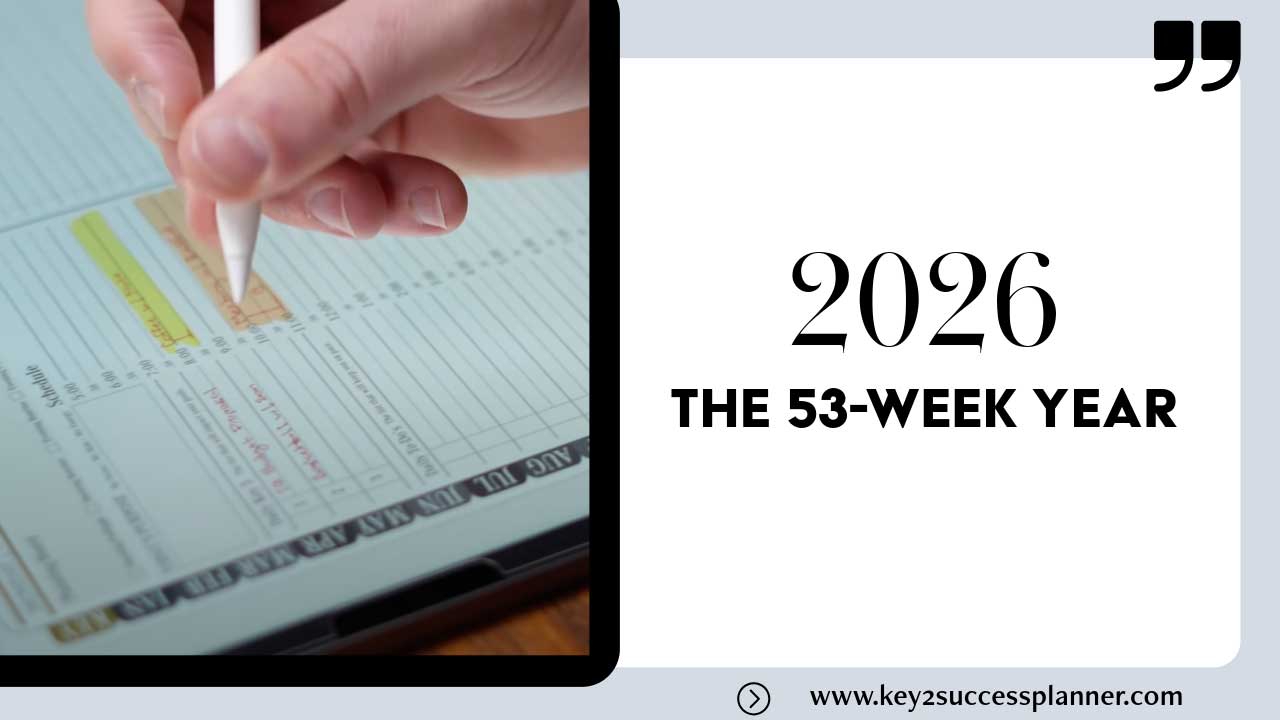2026 Has 53 Weeks: What That Means for Planning
2026 is a unique year because 2026 has 53 weeks (when going by the standard calendar week numbers for 2026, according to the ISO-8601 standard). Week 1 starts on Monday, December 29, 2025, and Week 53 starts on Monday, December 28, 2026. Let’s explore what that means for planning, specifically quarterly planning and the 12-week year planning styles.
2026 Weeks:
In 2026, according to the ISO-8601 standard, the first week of each quarter begins on the following dates:
| Quarter | Week Number | Start Date | End Date |
|---|---|---|---|
| Q1 | Week 1 | December 29, 2025 | January 4, 2026 |
| Q2 | Week 14 | March 31, 2026 | April 6, 2026 |
| Q3 | Week 27 | June 29, 2026 | July 5, 2026 |
| Q4 | Week 40 | September 28, 2026 | October 4, 2026 |
Please note that in the ISO-8601 system, weeks start on Monday, and Week 1 is defined as the week containing the first Thursday of the year. Therefore, Week 1 of 2026 starts on December 29, 2025. Additionally, 2026 has 53 weeks, with Week 53 starting on December 28, 2026.
Effective planning is crucial for achieving personal and professional goals. The Key2Success Digital Planner offers a comprehensive solution by integrating traditional quarterly planning with the dynamic 12-Week Year methodology. This fusion empowers users to maintain focus, enhance productivity, and realize their objectives efficiently.
Understanding Quarterly Planning
Quarterly planning involves segmenting the year into four distinct periods, each spanning approximately 13 weeks. This approach allows individuals and organizations to set manageable goals, assess progress, and adjust strategies as needed. By concentrating on shorter time frames, quarterly planning fosters adaptability and sustained motivation.
The 12-Week Year Methodology
The 12-Week Year, popularized by Brian P. Moran and Michael Lennington, challenges the traditional annual planning model. It posits that focusing on a 12-week period creates a sense of urgency, prompting individuals to accomplish more in less time. By treating each 12-week span as a year in itself, this system encourages concentrated effort, clear goal setting, and frequent performance evaluations.
Integrating the 12-Week Year into Quarterly Planning
While both quarterly planning and the 12-Week Year divide the year into segments, the latter emphasizes execution within a condensed timeframe. Integrating the 12-Week Year into quarterly planning involves:
- Setting Specific Goals: Define clear, measurable objectives for each 12-week period that align with overarching annual aims.
- Developing Action Plans: Break down each goal into actionable steps, assigning responsibilities and deadlines to ensure accountability.
- Monitoring Progress: Conduct weekly reviews to track advancements, identify obstacles, and implement necessary adjustments.
- Reflecting and Recalibrating: At the end of each 12-week cycle, assess outcomes, celebrate achievements, and plan for the next period.
The Role of the 13th Week
In this integrated approach, the 13th week of each quarter serves as a pivotal period dedicated to rest, review, and planning for the upcoming quarter. This week allows individuals to:
- Rest and Rejuvenate: Taking time off helps prevent burnout, ensuring sustained productivity in subsequent cycles.
- Conduct In-Depth Reviews: Analyze the successes and challenges of the past 12 weeks to extract valuable lessons.
- Strategize for the Future: Set new goals and refine strategies based on insights gained, ensuring continuous growth and improvement.
Leveraging the Key2Success Digital Planner
The Key2Success Digital Planner is designed to seamlessly incorporate the 12-Week Year framework into your planning routine. Its features include:
- Quarterly Keys Pages: These serve as a roadmap, aligning perfectly with the 12-Week Year structure. They guide users in setting priorities, outlining action steps, and visualizing progress over each quarter.
- Weekly Planning Tools: The planner offers dedicated sections for weekly planning, enabling users to allocate time effectively, focus on high-impact tasks, and maintain momentum throughout the 12-week period.
- Reflective Prompts: Regular prompts encourage introspection, helping users evaluate their performance, recognize successes, and identify areas for improvement.
Implementing the System
To maximize the benefits of combining quarterly planning with the 12-Week Year using the Key2Success Digital Planner:
- Initiate with a Vision: Clarify your long-term goals and aspirations to provide direction for your 12-week plans.
- Strategize Each Quarter: Utilize the Quarterly Keys Pages to outline specific objectives and corresponding action plans for each 12-week cycle.
- Engage in Weekly Planning: At the start of each week, use the planner’s tools to schedule tasks, set priorities, and allocate time for critical activities.
- Conduct Regular Reviews: Reflect on your progress weekly and at the end of each 12-week period, making data-driven decisions to enhance future performance.
By embracing this integrated approach, you can transform your planning process, boost productivity, and achieve your goals with greater efficiency. The Key2Success Digital Planner serves as a valuable ally in this journey, providing the structure and tools necessary for success.
For a visual guide on weekly planning with the Key2Success Digital Planner, consider watching the following video:








